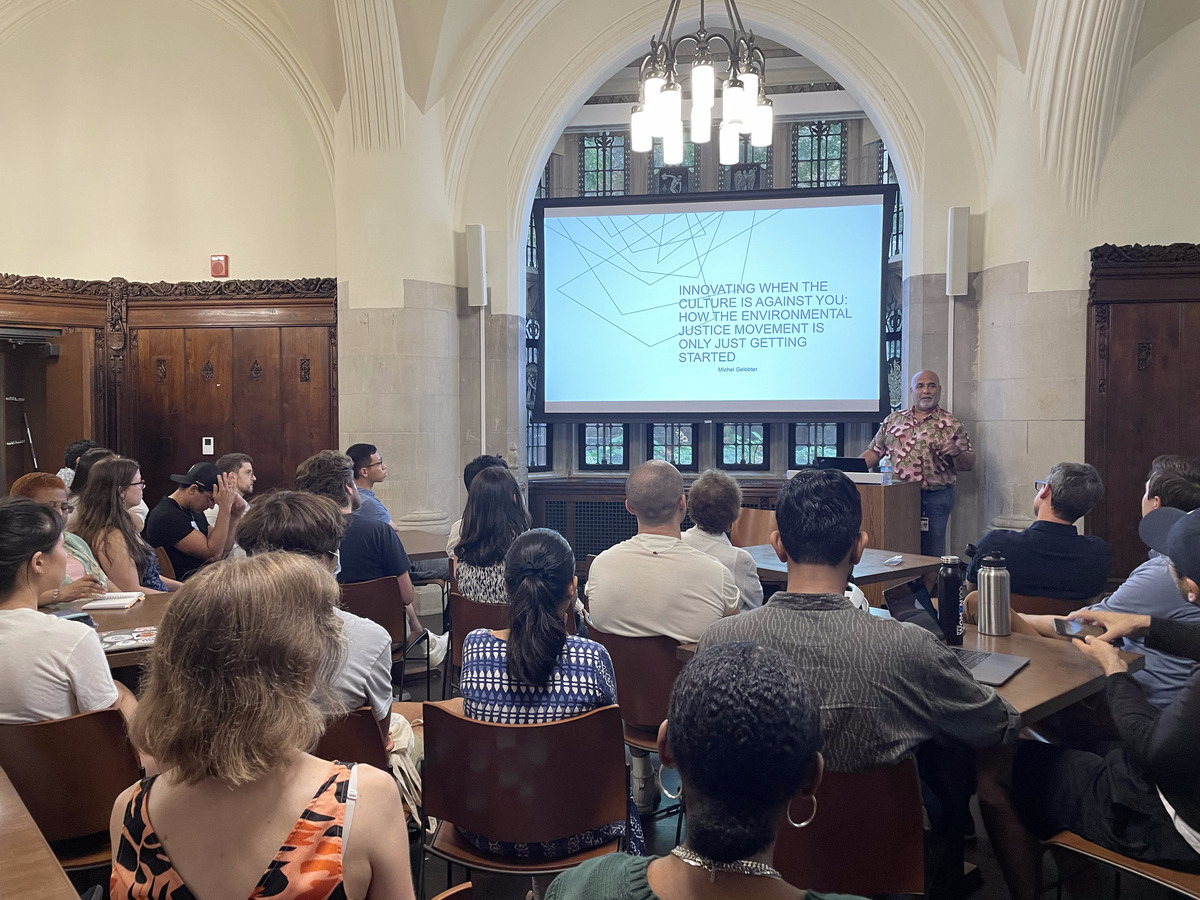“Environmental Justice” symposium takes on climate change, inequality
Attendees and presenters at the Yale Environmental Humanities program’s first symposium of the year looked at how the humanities are investigating climate change.

Hanwen Zhang, Contributing Photographer
Professors and graduate students across the University convened last Friday to sample some of the ways disciplines including architecture and Indigenous studies have approached the realities of a warming climate.
The discussions with professors and graduate students were part of the Yale Environmental Humanities program’s “Environmental Justice” symposium. The symposium on Sept. 8 was the first event of the year the program hosted. Three presenters — Anthony Acciavatti, a professor at the School of Architecture, Michel Gelobter, executive director of the Yale Center for Climate Justice, and Estrella Castillo GRD ’26, a graduate student studying the history of science — delivered brief presentations about their research and responded to audience members in an open Q&A session.
“It’s so wonderful to see the intersectionality of the environment with everything from cultural heritage to geopolitics,” Tara Vasanth ARC ’26, a graduate student at the School of Architecture, told the News. “It seems like there’s such a breadth of issues that we need all these different people to work on in order to collaboratively address climate change,” she added.
The Environmental Humanities program, an interdisciplinary graduate program, seeks to foster dialogue across different departments at the University and bring together different disciplines to approach climate change.
Presenting first at the symposium, Acciavatti drew on his 18 years of research, introducing the audience to the geography of the Ganges River and the seasonal shifts of its silt deposits, as well as the tools he uses for his research
Yale School of the Environment student Ananya Rao ENV ’25 said she was surprised by Acciavatti’s unconventional use of materials — such as rolls of clear tape and makeshift GPS systems — to sample soil composition along the Ganges River and map its seasonal changes.
As “one of the most hyper-engineered river systems on this planet,” as Rao called it, the Ganges River receives 1.6 billion tons of deposited silt each year. Meanwhile, the Triveni Sangam, a sacred site that sits at the confluence of the Ganges, Yamuna and Saraswati rivers, draws millions of pilgrims during the months of January and February each year for Magh Mela, a Hindu religious festival.
The entire city of Triveni Sangam — and its infrastructure including electricity, tents and running water — vacates “in less than two weeks’ time” as monsoon season sweeps in and washes away the sandbars. The structure of the city, according to Acciavatti, offers a preview of what future climate adaptivity could look like. Acciavatti said that Triveni Sangam’s tent city was “the most intelligent use of space” in its adaptability to the seasonal changes of the Ganges riverbanks.
Gelobter and Castillo, the other presenters, both focused on the social impacts of global warming.
Gelobter traced the history of the environmental justice movement, explaining how the movement has expanded the collective understanding of racism to encompass the pervasive, institutional effects of racial inequality.
Gelobter said that even though more people have started to understand how racism extends to our most basic resources, only 1.3 percent of philanthropic funding in the U.S. has gone to organizations led by people of color.
The challenge facing future environmental legislation, such as the Green New Deal or the Inflation Reduction Act, Gelobter said, is ensuring equal access to funding.
“There’s lots of ways hundreds of millions of dollars [that] have been devoted to low income and Black communities will be misused,” Gelobter said during his talk.
Castillo shared her ethnographic research in her presentation, which was centered on the loss of the peyote, a spineless cactus that is sacred to the Wixárika peoples of central Mexico. As explained in Castillo’s presentation, peyote was designated as a vulnerable species in 2009 due to changes in land use and underground industries that have started harvesting the plant for its psychotherapy uses. Peyote, a central piece of Wixárika religious practices, has declined due, in part, to recent mining and illicit harvesting. According to Castillo’s research, the loss of peyote has forced the Wixárika to walk further and further to find peyote.
Castillo identified the trend as being emblematic of cultural and environmental destruction supported by the forces of Western empiricism. Responsible use of Indigenous culture in mainstream science, she proposed, should instead respect Indigenous customs by “using variables based on traditional Indigenous following.”
Together, the speakers emphasized the importance of confronting the traditional notions of property and Western science in grappling with climate change. As a board member of climate startup incubator New Energy Nexus, Gelobter said that moving away from the carbon economy will require telling stories that bring companies together.
Botao Zhao ENV ’25, a student at the School of the Environment, said he appreciated the “the focus on environment from different perspectives.” He added that he was impressed by the way “the environment [brings] all [these] different disciplines and subjects together.”
The Yale Environmental Humanities program was founded in 2018.







